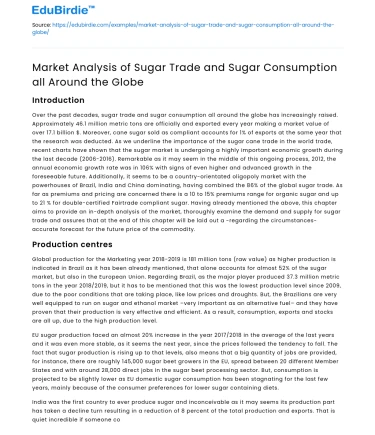Introduction
The sugar trade is a significant component of the global agricultural commodities market, influencing economies and diets worldwide. Historically, sugar has been an essential trade commodity, driving colonial expansion and impacting social and economic structures. Today, sugar remains pivotal, with its consumption intricately linked to health discussions and economic policies. The global sugar market is characterized by its complex supply chain, fluctuating prices, and diverse consumption patterns. This essay explores the dynamics of sugar trade and consumption by analyzing market structures, trade policies, and consumer behavior. It also examines the challenges posed by health concerns and sustainability issues, providing a comprehensive understanding of the current sugar market landscape.
Market Structure and Global Trade Dynamics
The global sugar market is dominated by a few key players, with Brazil, India, and Thailand being the top producers. Brazil leads the market, accounting for a substantial share of global sugar exports. According to the International Sugar Organization, Brazil produced over 29 million metric tons in 2020, primarily from sugarcane, making it a price-setter in the international market. India's sugar production is primarily for domestic consumption, yet it remains a significant player due to its large volume of production, reaching approximately 33 million metric tons in 2021. Thailand, on the other hand, is a major exporter, benefiting from favorable climatic conditions and government support for export-oriented production.
Save your time!
We can take care of your essay
- Proper editing and formatting
- Free revision, title page, and bibliography
- Flexible prices and money-back guarantee
Trade policies significantly impact the sugar market. Tariffs and subsidies are often used by countries to protect domestic industries, leading to market distortions. The European Union's Common Agricultural Policy, for example, has historically provided subsidies to European sugar beet farmers, affecting global sugar prices. Moreover, bilateral trade agreements and regional trade blocs such as ASEAN and Mercosur influence trade flows. These policies can lead to market inefficiencies, affecting producers in developing countries who rely on exports for economic growth. Additionally, fluctuations in oil prices impact sugar markets, as sugarcane is also a source for ethanol production, creating competition between sugar and biofuel sectors.
Consumption Patterns and Health Implications
Global sugar consumption patterns are diverse, reflecting cultural preferences, economic development, and dietary trends. Developed nations exhibit high per capita sugar consumption, with the United States leading, where the average individual consumes about 57 pounds of sugar annually. In contrast, developing countries, while experiencing rising consumption due to urbanization and increased disposable income, still consume less per capita. However, countries like India and China are witnessing rapid increases in sugar consumption, driven by changing dietary habits and the proliferation of processed foods.
The health implications of sugar consumption have become a focal point in public health discussions. High sugar intake is linked to obesity, diabetes, and other non-communicable diseases, prompting governments to implement measures like sugar taxes to curb consumption. For instance, the United Kingdom introduced a sugar tax on soft drinks in 2018, which resulted in a reduction in sugar content by manufacturers. Despite these efforts, challenges remain, as consumer preferences and industry lobbying often counteract health policies. Thus, balancing sugar consumption with health objectives continues to be a complex challenge for policymakers.
Sustainability and Future Challenges
The sustainability of sugar production is increasingly under scrutiny due to its environmental and social impacts. Sugarcane cultivation requires substantial water resources, often leading to conflicts in water-scarce regions. Moreover, the use of fertilizers and pesticides contributes to soil degradation and water pollution. The Fairtrade movement and sustainable certification schemes aim to address these issues by promoting environmentally friendly practices and ensuring fair wages for workers. However, the adoption of such practices is limited by economic constraints faced by smallholder farmers.
The future of the sugar industry will likely be shaped by technological advancements, policy shifts, and changing consumer preferences. Innovations in agricultural practices, such as precision agriculture and genetically modified crops, offer potential for increased efficiency and reduced environmental impact. Furthermore, the growing demand for alternative sweeteners, driven by health-conscious consumers, poses a challenge to traditional sugar markets. As countries strive to meet sustainability goals, the sugar industry must adapt to maintain its viability in a rapidly evolving global context.
Conclusion
The global sugar trade and consumption landscape is shaped by a multitude of factors, including market dynamics, health concerns, and sustainability challenges. While major producers like Brazil, India, and Thailand continue to dominate the market, consumption patterns are shifting due to health initiatives and changing consumer preferences. The industry's future will depend on its ability to adapt to environmental and technological changes while addressing health and sustainability concerns. As global demand for sugar evolves, stakeholders must navigate complex trade policies and economic pressures to ensure a balanced approach that supports both economic growth and public health objectives. The interplay between these elements will define the trajectory of the sugar market in the coming decades.






 Stuck on your essay?
Stuck on your essay?

